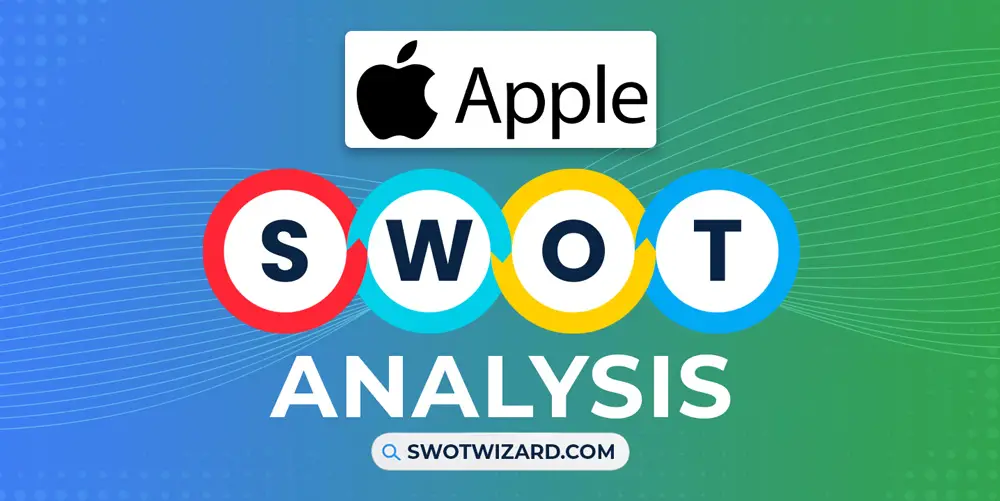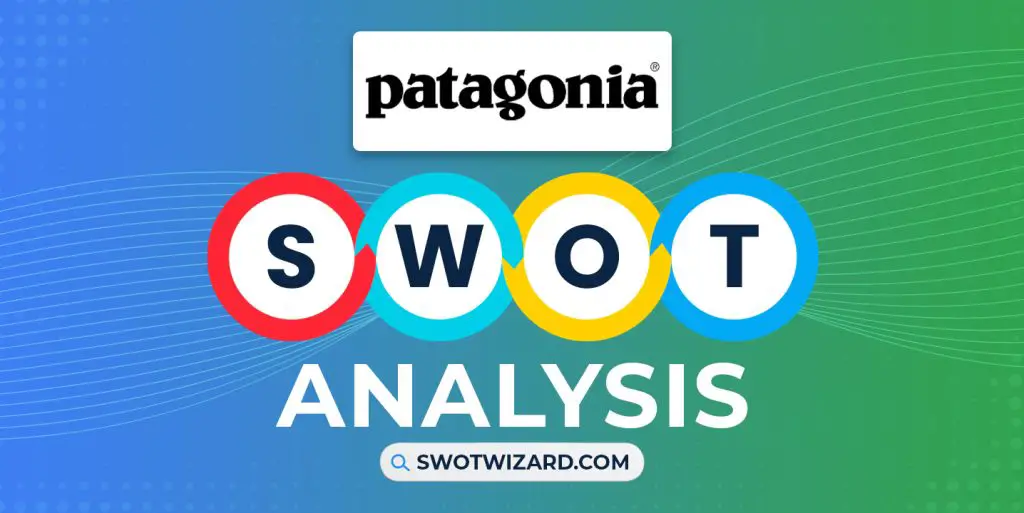New Balance holds the top fourth position in the manufacturing of the footwear industry, with a 3.4% US market share, even though it is one of the oldest shoe brands in the world, with 117 years of history. The company has gone through major famine, multiple world recessions, and wars and still has many strengths, weaknesses, opportunities, and threats, and in this New Balance swot analysis, we will learn about them.
New Balance: Company Overview
| Company | New Balance Athletics, Inc. |
| Industry | Footwear |
| Founded | 1906 |
| Founder | William J. Riley |
| CEO | Joe Preston |
| Headquarter | Boston, Massachusetts, U.S. |
| No. of Employees | 6,500+ |
| Annual Revenue | $5.3 billion (FY 2022) |
| Website | newbalance.com |
New Balance was founded in 1906 as the “New Balance Arch Support Company” in Boston, on the principle of providing arch supports and orthopedic shoes to help improve foot function and alleviate foot-related issues.
The company is doing the same to date and taking pride in its commitment to manufacturing a significant portion of its footwear in the United States. Besides, the company reported $$5.3B in global revenue in 2022 and had around 6,500 employees worldwide.
Product & Services of New Balance
Athletic shoes | Apparel | Sportswear | Sports equipment
New Balance Competitors
Nike | Under Armour | adidas | Reebok | PUMA | ASIC | Brooks Running
Did You Know?
New Balance has a unique numbering system for its shoe models. The numbers reflect the shoe’s characteristics, such as cushioning level and intended use.
Strengths – New Balance SWOT Analysis
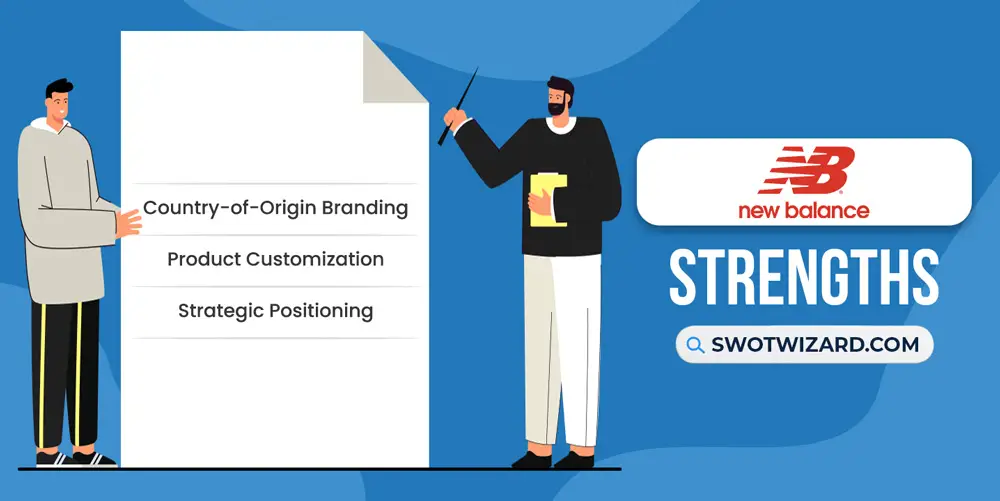
Country-of-Origin Branding: The company’s commitment to manufacturing a significant portion, over 70%, of its products in the United States enhances its country-of-origin branding. And the “Made in USA” collection showcases premium craftsmanship and materials, appealing to consumers who prioritize locally-produced products.
Product Customization: You won’t find this particular option everywhere, but New Balance offers customization options, allowing customers to personalize their footwear, providing a unique and personalized experience, and enhancing customer satisfaction and loyalty. The “NB1” program enables customers to customize various aspects of their shoes.
Strategic Positioning: The brand strategically positions itself as a brand that combines performance and style, catering to both athletic and lifestyle needs, allowing the company to tap into different consumer segments. And collaborations with fashion designers and influencers to create limited-edition collections that merge performance technology with trendy designs.
Weaknesses – New Balance SWOT Analysis
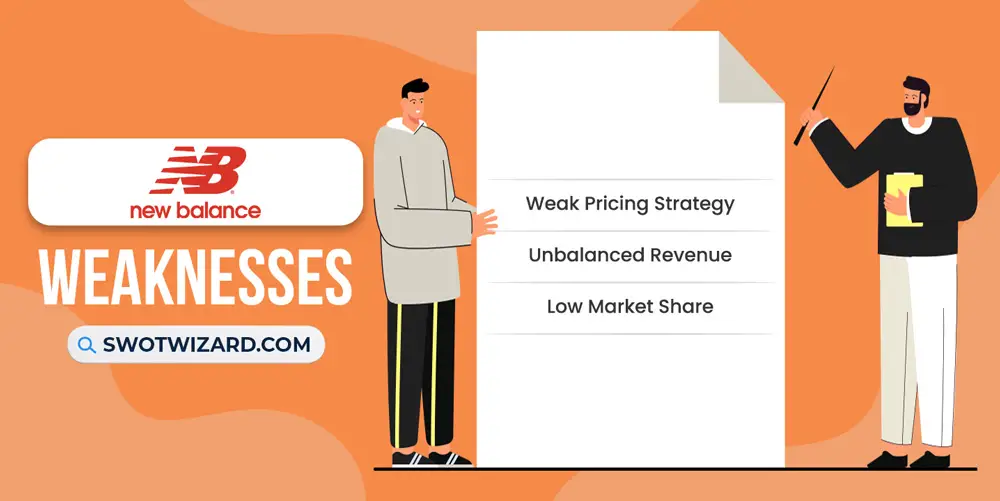
Weak Pricing Strategy: The company’s pricing strategy has been perceived as relatively higher than its competitors. As a result, The pricing strategy can deter price-sensitive consumers and limit market penetration. Besides, in a McKinsey survey, most respondents considered New Balance products to be overpriced compared to other athletic brands.
Unbalanced Revenue: Even though the company has an international presence, in terms of revenue, only a few regions or countries account for most of it. The USA and North America region hold almost 76% of the sales, and the others hold the rest. As a result, if there is any economic issue or anything in these countries, it holds the company to reach its full potential.
Low Market Share: New Balance is a well-known company with a reputation and massive sales. But, despite its strong brand reputation, New Balance struggles to capture significant market share in the highly competitive athletic footwear market. According to data, New Balance held less than 5% of the global athletic footwear market in 2022.
Opportunities – New Balance SWOT Analysis

Offerings Diversification: There are vast expansions of its product offerings beyond footwear and apparel to capitalize on growing fitness and wellness trends. Introducing accessories like fitness trackers or partnering with wellness brands for co-branded products can enhance its market presence and cater to evolving customer needs.
Market Expansion: Product diversification isn’t enough; they need to do more as they can tap into emerging markets with rising disposable incomes and a growing middle-class population. Specifically, targeting countries in Southeast Asia, such as Indonesia and Vietnam, where the sports and fitness industry is experiencing significant growth, can help increase market share and revenue.
Tech Adaptation: Embracing technological advancements can give New Balance a competitive edge. Integrating smart features into footwear, such as built-in fitness tracking or personalized coaching apps, can attract tech-savvy consumers seeking innovative and connected products. Collaborating with technology companies or investing in research and development can facilitate the adoption of new technologies.
Threats – New Balance SWOT Analysis
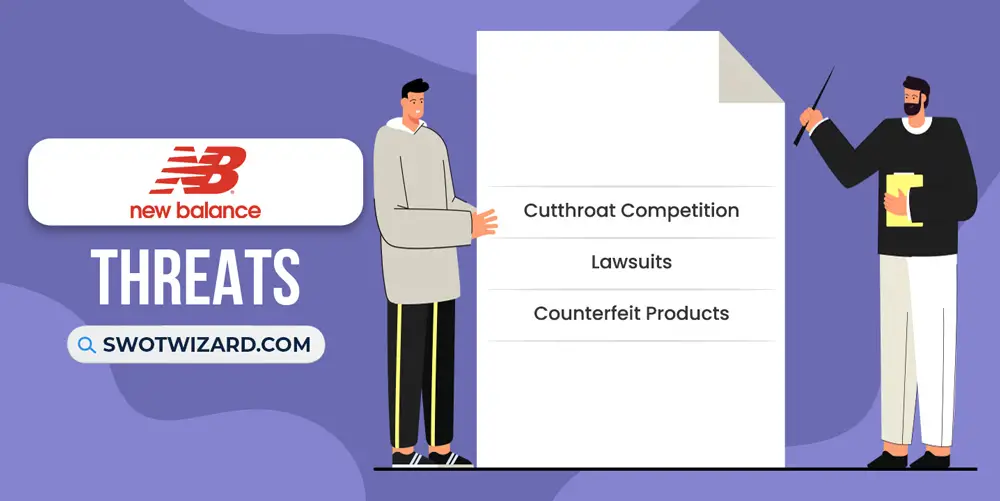
Cutthroat Competition: Even though New Balance is an old company with hundred years of experience, they are falling behind and faces intense competition from industry giants like Nike and Adidas, which have larger market shares and substantial marketing budgets. If we see the revenue numbers, Nike exceeded $46.71B, dwarfing New Balance’s revenue of around $5.3B in 2022.
Lawsuits: A few years ago, the company faced a trademark infringement lawsuit from Converse, alleging that New Balance had copied Converse’s iconic Chuck Taylor All-Star design. And another lawsuit is still going on about misleading and false advertisements about using made-in-USA, which is costly and time-consuming, potentially impacting the company’s resources.
Counterfeit Products: Counterfeit products dilute the brand’s value and lead to revenue loss and potential harm to consumers. And as a reputed and recognized brand, thousands of counterfeit shoes are in the market, and it is growing. And as a part of the process, the company is in a counterfeit lawsuit battle with China and its counterfeit market.
[Bonus Infographic] SWOT Analysis of New Balance
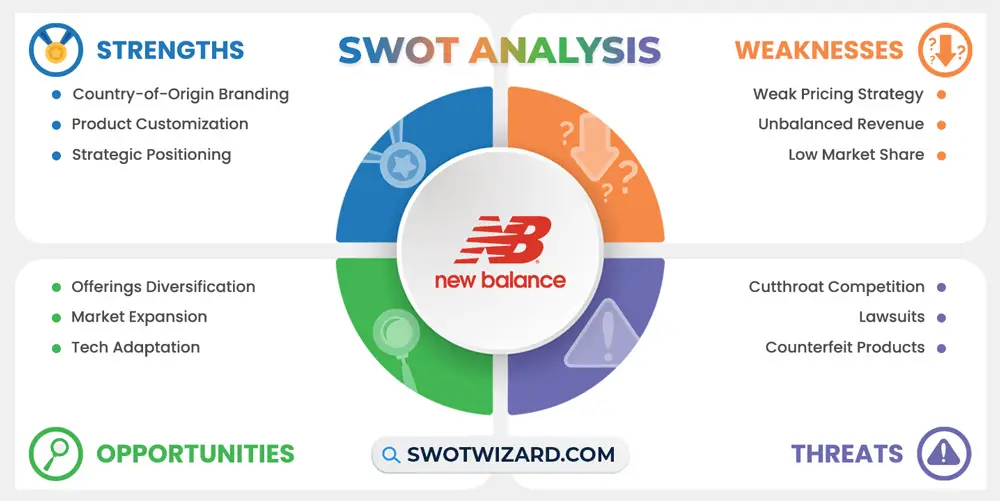
Recommendations for New Balance
The footwear market is growing, and so is the competition in the market. To survive and grow its market share, New Balance should up its game.
- Identify and target untapped markets with high growth potentials, such as emerging economies or regions where New Balance has a limited presence.
- Establish strategic partnerships with local retailers or distributors to penetrate new markets effectively.
- Explore collaborations with renowned designers or influencers to create exclusive, trendsetting collections that appeal to fashion-conscious consumers.
- Explore incorporating wearable technologies or smart features into footwear and apparel.
Frequently Asked Questions (FAQs)
Is New Balance a premium brand?
Yes, New Balance is a premium brand with premium quality products.
Who are New Balance’s competitors?
New Balance's competitors are Nike, Adidas, Under Armour, Puma, Reebok, ASICS, and Skechers.
Final Words on New Balance SWOT Analysis
New Balance, with its strong brand reputation and commitment to quality craftsmanship, faces challenges from intense competition, lawsuits, and counterfeit products. However, by focusing on market expansion, diversifying offerings, and embracing technology, the company can position itself for sustained growth and success in the dynamic athletic footwear industry.
References
- Wikipedia contributors. (n.d.). New Balance. Wikipedia.
- Thomas, L. (2022, March 28). New Balance bulks up manufacturing presence in U.S. amid global supply chain backlogs. CNBC.
- Guyot, O. (2023, March 3). New Balance reports 2022 revenue of $5.3 billion. FashionNetwork.com.
- Yeung, J. (2021, February 10). New Balance Wins $3.8 Million USD Trademark Lawsuit Against Chinese Brand “New Barlun.” Hypebeast.
- Lawsuit accuses New Balance of false walking shoe ads. (2011, January 10). FashionNetwork.com.


